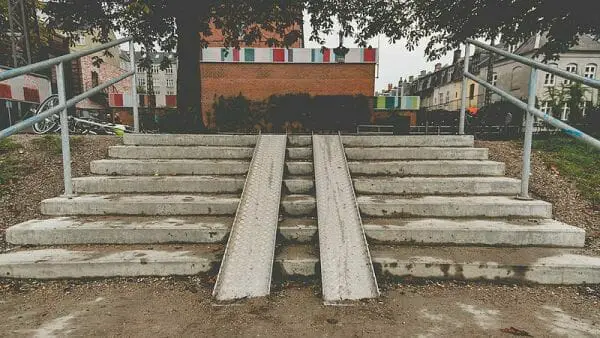
Your power or manual wheelchair has immense benefits for you. You have rediscovered your mobility and freedom on your wheelchair. It has helped you get back your access to most public places. You probably have joined back at your workplace. All said, you feel really liberated and rightly so!
So, when you see those flight of stairs in front of you, which are not complemented by an elevator or a ramp, it may feel like a step back into the past. If you are ever in a situation like this, read on. We discuss in detail various ways of getting a wheelchair up or down stairs.
Contents
Get a Wheelchair Up and Down Stairs
Nowadays, there are strict guidelines around accessibility as far as public and commercial buildings are concerned. There should be a wheelchair-friendly way to access that which lies beyond the flight of stairs.
So you may not need to get a wheelchair up or downstairs too often. This problem will mainly arise in older constructions or more often in your own home, or other private spaces.
An obvious way to reduce getting a wheelchair up or downstairs in your house to a minimum is to try and bring all your necessities within the ground or lowermost floor.
But if you really want to be able to enjoy all the spaces your house has to offer, you will need to get our wheelchair up and downstairs often. We will discuss various devices or modifications that can help you do so.
There are two kinds of flight of stairs we will be talking about in this article.
The first one is a short flight of stairs, like the ones at the front of the house. These will probably about have a maximum of 6 steps with a height difference between the lowest and highest step not more than 3-4 feet.
The second one is a full flight of stairs. The kind that goes in between floors or levels within a house.
Preparing the Wheelchair to be Transported Up a Flight of Stairs
Whether you are using a manual transport wheelchair or a power wheelchair, taking these basic precautions and steps will help make getting a wheelchair up or down a flight of stairs easier and safer.
- Please make sure that all extra weight is taken off the wheelchair. For example, bags, umbrellas and water bottles. The lower the combined weight of the wheelchair, while going up, the better.
- Let us get an idea of the kind of weight that you would be pushing up the stairs. Assuming you own a power wheelchair, which is, on an average, 60 – 70 pounds excluding the battery weight. Average human weight on wheelchair will be another 160 – 200 pounds. So, the total weight can range from 220 – 270 pounds (~ 100 – 120 kgs).
- Remember to switch the mode of your wheelchair to manual if you are using a power wheelchair. Accidental powering on and use of joystick may result in mishaps. Unexpected movement while transporting a wheelchair up a flight of stairs may cause serious injuries to both the user of the wheelchair and the attendant.
- If your power wheelchair has inflatable tires, keep your tires inflated to optimal air pressure. It may not be applicable if your wheelchair has solid rubberized tires. Lower pressure in the tires will increase friction. That, in turn will increase the effort required to push the wheelchair up. Having a tire inflating kit at home always helps.
- Make sure that if your wheelchair has a seat belt, it is firmly fastened around you.
- Use anti-skid tape on each of the steps on the staircase to prevent attendants from slipping while transporting the wheelchair.
You may also like Best Slip Free Strips and Treads for Indoor Stairs
Different ways of Getting a Wheelchair up Flight of Stairs
Install Temporary Wheelchair Ramps
If you need to go up a short flight of stairs, you can consider installing a temporary wheelchair ramp beside the stairs.
Even then, to get up the stairs on your own, you would need a powerful electric wheelchair and a sufficiently large landing space beyond the ramp to stop and maneuver your wheelchair.
You would certainly need human help in all other cases. Below, I have explained a few ways to get your wheelchair up the stairs with as minimum an effort and help as possible. Please read on.
Install Divided Ramps or Tracks on Stairs
This is mainly a solution for going up the full flight of stairs at your home. This method requires permanent installations on your flight of stairs. It may slightly reduce the aesthetics of your home.
But it will go a long way to increase the your mobility within your house. It will also decrease the number of attendants required to safely get your wheelchair up the stairs from two to one. These tracks are best installed with professional help.
The first thing that should be kept in mind for the installation is to accurately measure the width of the wheels of your wheelchair. If you own a power wheelchair your wheel width will be much greater than that of a manual wheelchair. The tracks should ideally be just about an inch wider than your wheelchair tires. The rims of the tracks should not be too high. Otherwise they may interfere with the outer rims of the manual wheelchair tires (rims which you would generally hold to self propel your chair). You will do well to test if your wheelchair is going on the rails smoothly, before installing them.
The second step should be to firmly attach both the rails to two sides of the staircase. Measure the distance between the two wheels and install the two rails accordingly. Let us reemphasize, you should get professional help for doing this. The rails should be screwed on to the concrete in at least 4 – 6 places (for a staircase with 12-15 steps) to prevent shaking. You should ensure testing of the rails with an empty wheelchair (probably with artificial weights to simulate actual weight) first, before actual everyday use.

Your attendant should be first aligning the wheels properly on the tracks before pushing your wheelchair by holding the handle bar at the back of the seat or head rest for maximum ease and safety. You should not lean forward on your seat, while being pushed up, but align your posture as much as possible to the natural shape of the wheelchair.
Please do not try and scale the stairs using the tracks, on a powered wheelchair, all by yourself. Most powered wheelchairs will not have that kind of motor boost to scale that slope and moreover, there are chances of toppling over and sustaining serious injuries.
Finally, as a regular activity, you should be checking the installation for any defects / loose screws, to prevent potential accidents.
This is not a standard product that you may find listed on en e-commerce website. You may have to search for a bit among local vendors or probably order one according to your exact specifications. Its total length will depend on the exact number of steps.
The rails should be rounded off at the edges (both at the sides and at the end points) to allow safe use of the staircase for other users, especially children. Rubberized rim guards will also go a long way to ensure the overall safety of the installation.
Caution: Always make sure to get attendant help while going up or coming down the stairs on a wheelchair.
You may also like Best Stair Chair Lift For Seniors
Wheelchair lift to go up or down a flight of stairs
A wheelchair lift is a platform on which you can park your wheelchair and the platform can then be operated (usually by an attendant) to move you and the wheelchair up or down a flight of stairs. You are more likely to see them in commercial establishments. A wheelchair lift for straight stairs itself starts at around $3000. Its cost goes up if the stairs are curved or an enclosure is needed. The installation may cost you another $1000 or more depending upon the modifications needed.

Caregiver assisted approach
There will be situations when you would not be able to implement any of the above. Or, sometimes your home layout may be such that installing a ramp or tracks is not possible. Or, you may have a spiraling flight of stairs. In these cases, you will have to take help of attendant(s), usually 2.
Stronger of the two attendants should be pushing your chair from behind while the tires ascend each step. The second attendant should provide support to the wheelchair and ensure proper direction from the front. The attendant in the front should be making sure not to hold any loose or removable piece of the wheelchair. Please make sure that the wheelchair is held from the metal parts of the wheelchair or by a harness tied to the chair. She should also be careful with her steps as mostly she will be scaling the steps backwards.
Below is a video showing how to safely get a wheelchair up a flight of stairs.
Hand Railings on the Side of the Staircase
Finally, whichever method you are using to transfer your chair up the stairs, you will do well to install a firm hand railing on the sides of the staircase.
The best practice for the user is to always hold this railing while attendant(s) are lifting the chair up the steps. This goes a long way to reduce the impact of wrong footings, accidents and any unforeseen circumstances.
You may also like Best Power Wheelchairs for Outdoor Use
Conclusion
You should consider getting up a flight of stairs as an exceptional situation in your otherwise new found mobile lifestyle. Therefore, you should never hesitate in asking for help.
Always remember that trying to get up a flight of stairs on your wheelchair without help is fraught with risks and has many reported cases of accidents and aggravated injuries.
The amount of help you need may be reduced by applying some of the strategies explained above. Stay safe and happy wheeling!
